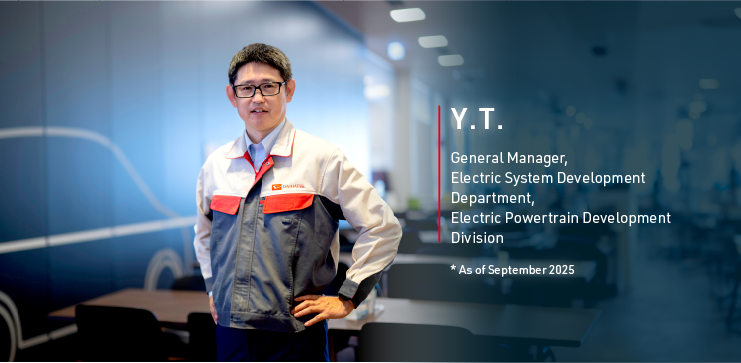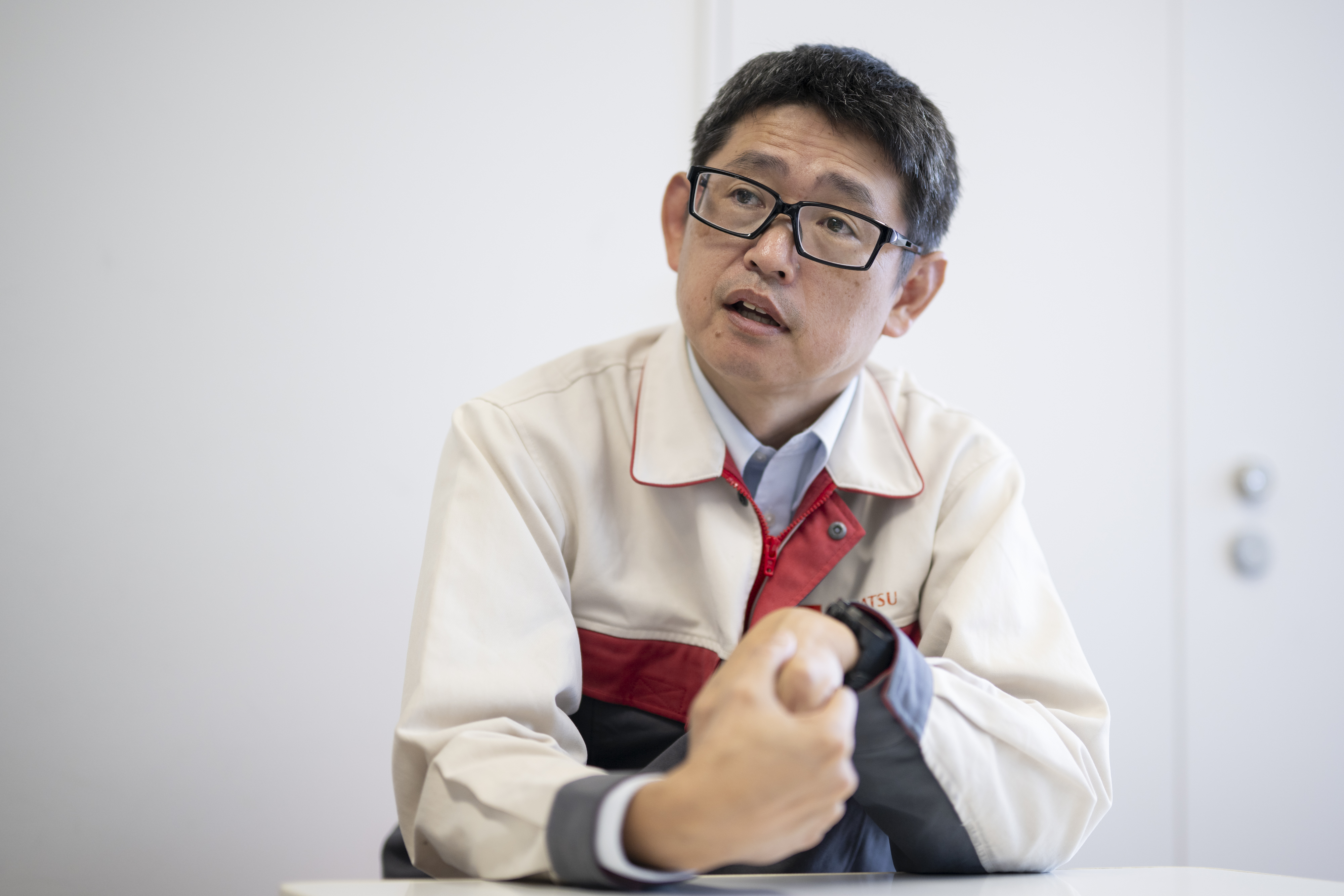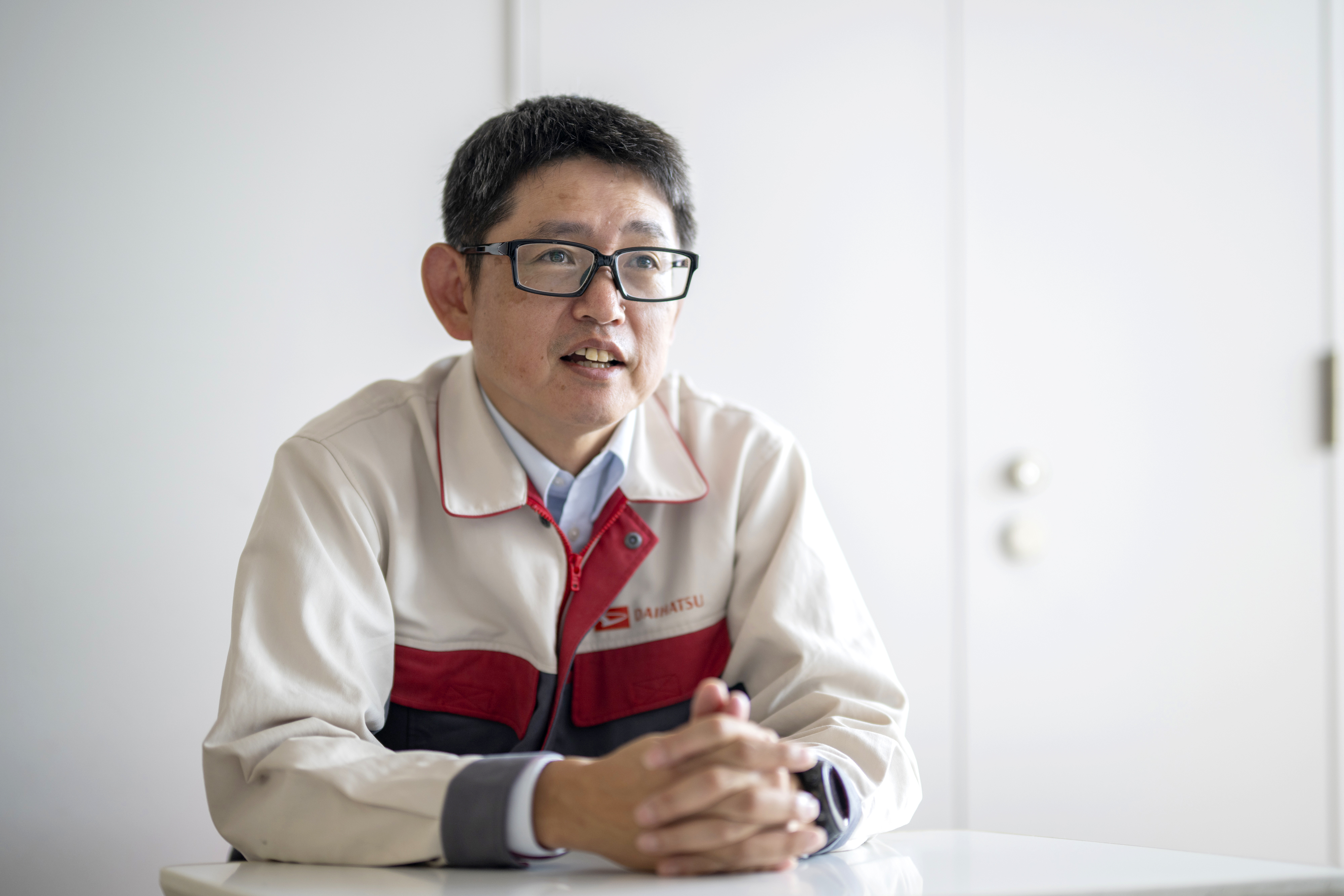Addressing Climate Change - 1

Staying Close to People and Serving the Planet
—Daihatsu’s Unique Approach to Electrification
Working for the Environment—
Daihatsu’s Electrification Contributing to the Earth Defense Corps
My division is responsible for the design and development of all electrical systems related to batteries, motors, and vehicle drive control. The Electric System Development Department also handles electrical systems for the e-SMART HYBRID and the e-SNEAKER personal mobility device provided at the Osaka Expo.
We believe in working for the environment, and we playfully call ourselves the “Earth Defense Corps.” How can we use technology to tackle global-scale problems? That is the question we pose to ourselves as we engage in development every day.
Searching for a Unique Daihatsu Hybrid

Full-scale development of the e-SMART HYBRID began around 2017. I have been involved since the beginning of development, and initially, there were just a few members who were searching for some foothold to get started. We began with a question: What is the right way to make a Daihatsu-style hybrid?
We aimed to create a hybrid system that is ideal for compact and mini-vehicles. After considering a few different methods, we arrived at the series structure. This extremely simple structure uses an engine to generate electricity to drive a motor. The construction is also simple, with the engine and wheels not being directly connected, and can be built for a reasonable cost. Daihatsu has a long history in developing specialized technology for highefficiency engines used in mini-vehicles. Fully drawing on this strength, we are working to enhance compatibility with the series structure as we pursue optimization of our dedicated engine for power generation. As we turn our eye to future expansions of our electric vehicle lineup and creating the mobility society that meets our customers’diverse needs, this system is also very flexible and expandable, making it ideal for Daihatsu as a company that specializes in small cars.
Another major theme was how to strike a balance between fuel efficiency performance and price. We decided to choose a somewhat challenging direction that is distinctly Daihatsu: reducing battery capacity while boosting performance with efficient control technology. Rather than emphasizing the electric aspect, we focus on striking a balance between total efficiency and cost.
We also went through several rounds of fine-tuning with respect to comfort-related aspects of the system, such as sound and vibration while operating. For example, we are tuning the type of sound the engine makes when started up and the way the motor moves so that it does not cause any discomfort during driving. During development, we aimed to achieve a final level of comfort that allows people to ride as naturally as possible, without necessarily seeking out an electric vehicle per se.
Passion for Manufacturing That Arises from Face-to-face Development
Passion for Manufacturing That Arises from Face-to-face Development In the development process, we at Daihatsu prioritize face-to-face relationships. Personnel involved in design, prototyping, control, assessment, and other phases of the development process work closely together, constantly sharing information on the current situation. Instead of strict division of the process such as evaluators only working on drive tests or designers only working on design, everyone works together as a single team to make the workplace function. That atmosphere is our strength. In general, we also conduct driving tests ourselves. For example, in the course of developing the Rocky, the General Manager at the time and I started the year off by running endless laps on the test course as a duo. If there was something that seemed off to us, we would stop right there and set to work trying to improve it. That sort of diligence is at the heart of our work style.
All of us are genuinely invested in making cars that will make customers happy. When the e-SMART HYBRID launched, we really felt our hard work had been rewarded when we received all the feedback saying it had good fuel efficiency and was quiet and smooth to drive. We also received some real feedback that people wanted more of a sense that they were driving an electric-powered vehicle. We cherish this feedback and work to put it to good use in our next round of product development.
Creating World-class Technology

e-SMART HYBRID was deployed in Malaysia on a limited basis with the intent of introduction in Indonesia in the future. Street conditions, electricity, and usage environments differ from country to country, so I believe it is most important to prepare choices appropriate to each country. In other words, rather than providing a single minimal solution, we take a multi-pathway approach that embraces multiple solutions. Whether BEV, hybrid, hydrogen, or biofuel is the best choice depends on the region and purpose of use, so it is currently not possible to simplify down to a single solution.
In Japan, charging infrastructure is still developing, and there are some unique circumstances facing daily users. That is why I believe that there is a BEV that fits the specific needs of Japan best. We need to think thoroughly about this question and propose BEVs that are suited to their region of use. For example, e-SNEAKER is very focused on safety features for its intended senior citizen users, so it has been thoroughly tested in a variety of situations. I believe that e-SNEAKER does a wonderful job of capturing Daihatsu’s unique form of mobility that stays close to people.
Into the Future with a Diverse Team
My current team has people from a wide range of backgrounds, starting of course with young people and including women, foreign nationals, and senior-citizen veteran employees. Each draws on their own unique qualities in the development process.
I always strive to properly grasp each individual member’s thoughts and strengths, regardless of their position or age. To that end, I place a lot of weight on everyday casual conversation and one-on-one dialogue opportunities. I pick up on off-hand comments about what type of work people would like to do and what their strengths are, and think together with the team about how we can all grow together. I try to develop our relationships in that way.
We aspire to bring our customers high costperformance vehicles with guaranteed safety and quality. To make this a reality, we work to stay close to our customers’ lifestyles and contribute to the environment. That is the sort of vehicle manufacturing to which we aspire.
Of course, there is still so much more that we want to do. That is why our approach will continue to be a forwardlooking feeling of “Let’s give it a try” as we take on the challenges ahead. In a uniquely Daihatsu way, and in a uniquely Earth Defense Corps way, we hope to keep progressing forward one step at a time.